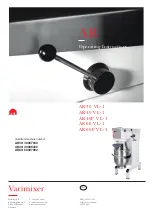
2-3-3. REVERB RETURN TO MAIN CONTROL. This
control determines how much of the signal from the
reverb system is added or returned to the main mix.
2-3-4. REVERB RETURN TO MONITOR CONTROL.
Determines how much of the signal from the reverb
system is added to the monitor mix. Many vocalists
like to hear some reverb on their voices in the monitor
system; be aware that reverb in the monitors increases
the likelihood of feedback in the monitor system due
to increased gain.
2-3-5. EFF./REV. SEND LEVEL CONTROL. The mix
created by the settings of the channel EFF./REV. con-
trols appears at the EFF. OUPUT jack, as well as being
sent to the reverb system. The signal level at the EFF.
OUTPUT jack is adjusted by the individual channel
EFF./REV. controls, and the EFF./REV. SEND LEVEL
master control.
2-3-6. AUX. LEVEL CONTROL. Signals patched into
the AUX. INPUT jack and / or the TAPE INPUTS are
sent to the Main buss via the AUX. LEVEL control. This
control determines how much of the AUX. INPUT sig-
nal appears in the main mix.
2-3-7. GRAPHIC EQUALIZER. The 9 band graphic
equalizer consists of active band pass / band reject fil-
ters spaced at octave intervals. The lowest frequency
filter is centered at 63Hz while the highest frequency
filter is centered at 16kHz. All others are centered on
the frequencies indicated below their sliders. Moving
the sliders up or down boosts or cuts the gain at the
indicated frequencies. This allows the sound engineer
to suppress feedback by compensating for room reso-
nances encountered in live sound reinforcement appli-
cations. The EQ controls are accurately scaled in dB to
indicate the amount of cut or boost applied at each
frequency.
NOTE: It is possible for distortion to occur in the
Graphic Equalizer if excessive attenuation is used (slid-
er well below center) while also trying to achieve sig-
nificant level within the attenuated bands.
2-3-8. DIGITAL REVERB AND EFFECTS CONTROLS.
The internal DSP (Digital Signal Processor) system pro-
vides 126 different types of reverb and effects. These
are selected by the two rotary switch controls located
in the DIGITAL REVERB and EFFECTS section of the
front pannel. These two controls work together to
select and modify each reverb sound or effect algo-
rithm. When the bottom switch chooses one of the
fourteen reverb selections, the top switch chooses the
reverb or delay time. When the bottom switch is in the
SPECIAL EFFECTS setting, the top switch chooses the
special effects algorithm. This is indicated by the pan-
nel graphics, which show light and dark colored sec-
tions.
2-3-9. PHANTOM POWER (Select Switch and
Indicator LED). Engaging the switch applies 15 volts of
phantom power to all the XLR microphone input con-
nectors for powering electret condenser microphones.
When the LED is illuminated, the phantom power is
on. The 15 volts used for phantom power will run
nearly all condenser microphones.
PHANTOM POWER LED. The green LED is the “phan-
tom power on” indicator.
2-3-10. DELTACOMP
TM
. The yellow DELTACOMP
TM
LED comes on when excessive signal levels are being
sent to the power amp. It illuminates on signal peaks
that cause clipping (distortion) with DELTACOMP
TM
not
activated, or for signal peaks that cause DELTACOMP
TM
to reduce power amp input level (DELTACOMP
TM
active). If the limiter is on for a large percentage of the
time, the dynamic range of the system is reduced and
the overall sound suffers; for this reason, level controls
should be adjusted so that the LIMIT light only flashes
on occasional signal peaks.
DELTACOMP
TM
SWITCH. DELTACOMP
TM
is activated by
engaging the DELTACOMP
TM
SWITCH.
2-3-11. POWER LED. The red POWER LED is the front
panel “power on” indicator.
2-4. PATCH BAY.
2-4-1. MAIN OUTPUT. Signals from each of the
channels are combined with AUX. and TAPE INPUTS
and the REVERB RETURN TO MAIN signal to form the
final main mix. The overall level of the mix is con-
trolled by the MAIN MASTER control and this mix
appears at the MAIN OUTPUT jack. The mix is also
normally passed on to the GRAPHIC EQUALIZER and
to the power amplifier (see Sections 2-4-5 and 2-4-9).
Inserting a plug into the MAIN OUTPUT jack does not
interrupt the normal signal flow. It can be used for
inserting signal processing equipment into the signal
path (see Section 4-5), using the MAIN OUTPUT as a
send, and the GEQ INPUT as a return.
2-4-2. MONITOR OUTPUT. Signals present on the
Monitor buss are combined in the monitor summing
amplifier and sent to the MONITOR OUTPUT jack.
The signal level present at this output is determined by
the MONITOR MASTER control.
2-4-3. EFF. OUTPUT / REVERB FOOTSWITCH. Signals
present on the Effects/Reverb buss are mixed in the
Effects/Reverb summing amplifier. This mix is sent
both to the Reverb driver and to the EFF. OUTPUT
jack. Thus the mix created by the settings of the
EFF./REV. level controls on each of the preamp chan-
nels is present at the EFF. OUTPUT jack. The overall
level at this output is determined by the master mix
section EFF./REV. SEND LEVEL control. This output
may be used to drive external effects (echo units,
phase shifters, flangers, digital delays, etc.). The
return signal from the effect may be patched into the
mixer through the AUX. INPUT jack, or by way of a
preamp channel 1/4” input jack. Use of a preamp
channel as a return gives you the ability to shape the
frequency response of the signal; however, care must
be taken to insure that the EFF./REV. control on that
































